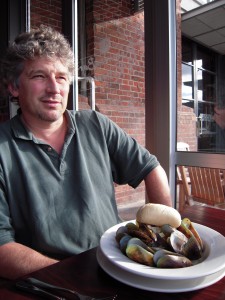I enjoy a good mussel, with the broth and the bread and the beer.

This report describes an outbreak investigation starting with two closely related suspected food-borne clusters of Dutch hepatitis A cases, nine primary cases in total, with an unknown source in the Netherlands. The hepatitis A virus (HAV) genotype IA sequences of both clusters were highly similar (459/460 nt) and were not reported earlier. Food questionnaires and a case–control study revealed an association with consumption of mussels.
Analysis of mussel supply chains identified the most likely production area. International enquiries led to identification of a cluster of patients near this production area with identical HAV sequences with onsets predating the first Dutch cluster of cases.
The most likely source for this cluster was a case who returned from an endemic area in Central America, and a subsequent household cluster from which treated domestic sewage was discharged into the suspected mussel production area.
Notably, mussels from this area were also consumed by a separate case in the United Kingdom sharing an identical strain with the second Dutch cluster.
In conclusion, a small number of patients in a non-endemic area led to geographically dispersed hepatitis A outbreaks with food as vehicle. This link would have gone unnoticed without sequence analyses and international collaboration.
International linkage of two food-borne Hepatitis A clusters through traceback of mussels, The Netherlands, 2012
Eurosurveillance, Volume 21, Issue 3
Boxman I, Verhoef L, Vennema H, Ngui S, Friesema I, Whiteside C, Lees D, Koopmans M.
http://www.eurosurveillance.org/ViewArticle.aspx?ArticleId=21356
